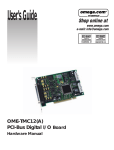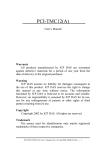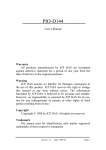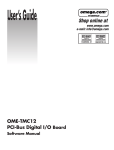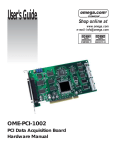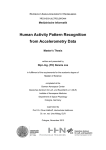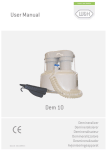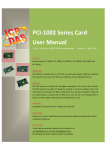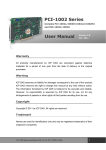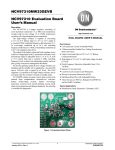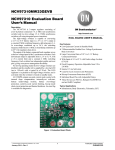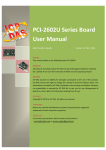Download PCI-TMC12 User Manual
Transcript
PCI-TMC12
User Manual
Warranty
All products manufactured by ICP DAS are warranted
against defective materials for a period of one year from the
date of delivery to the original purchaser.
Warning
ICP DAS assume no liability for damages consequent to
the use of this product. ICP DAS reserves the right to change
this manual at any time without notice. The information
furnished by ICP DAS is believed to be accurate and reliable.
However, no responsibility is assumed by ICP DAS for its use,
nor for any infringements of patents or other rights of third
parties resulting from its use.
Copyright
Copyright 1999 by ICP DAS. All rights are reserved.
Trademark
The names used for identification only maybe registered
trademarks of their respective companies.
PCI-TMC12 User Manual (Ver. 1.0) ----- 1
Tables of Contents
1. INTRODUCTION.................................................................................................................................. 3
1.1 P RODUCT CHECK LIST ........................................................................................................................ 3
2. HARDWARE CONFIGURATION..................................................................................................... 4
2.1 BOARD LAYOUT ................................................................................................................................. 4
2.2 COUNTER ARCHITECTURE ................................................................................................................... 5
2.3 D/I/O BLOCK DIAGRAM..................................................................................................................... 6
2.4 J UMPER SETTING................................................................................................................................. 7
2.5
DAUGHTER BOARDS.........................................................................................................................11
2.6 P IN ASSIGNMENT ..............................................................................................................................15
3.
I/O CONTROL REGISTER...........................................................................................................17
3.1 HOW TO FIND THE I/O ADDRESS........................................................................................................17
3.2 THE ASSIGNMENT OF I/O ADDRESS ....................................................................................................19
3.3 THE I/O ADDRESS MAP .....................................................................................................................20
4.
8254 PROGRAMMING ...................................................................................................................25
4.1
CONTROL WORD FORMAT ...............................................................................................................25
4.2 COUNTER LATCH COMMAND.............................................................................................................26
4.3 READ BACK COMMAND ....................................................................................................................26
4.4 STATUS BYTE FORMAT......................................................................................................................26
5.
DEMO PROGRAM .........................................................................................................................27
5.1 DEMO1: USE D/O.............................................................................................................................28
5.2
DEMO2: USE D/I .............................................................................................................................30
5.3
DEMO3: WAVE GENERATOR............................................................................................................32
5.4
DEMO4: DELAY ONE MS .................................................................................................................34
5.5
DEMO5: 16-BIT EVENT COUNTER ....................................................................................................36
5.6
DEMO6: SOFTWARE COUNTER ........................................................................................................38
5.7
DEMO7: WATCHDOG TIMER ............................................................................................................40
5.8
DEMO8: P ULSE WIDTH MEASURE ...................................................................................................44
5.9
DEMO9: FREQUENCY MEASURE .......................................................................................................47
5.10 DEMO10: FIND CARD NUMBER ......................................................................................................51
5.11 DEMO11: COUNT LOW P ULSE .......................................................................................................52
5.12 DEMO12: LOW P ULSE WIDTH .......................................................................................................55
5.13 DEMO13: HIGH P ULSE WIDTH .......................................................................................................59
PCI-TMC12 User Manual (Ver. 1.0) ----- 2
1.
•
•
•
•
•
•
•
•
•
•
•
•
•
•
•
•
•
Introduction
The PCI-TMC12 is a general purpose counter/timer and digital I/O card
PC AT compatible PCI bus
On-board four 8254 chips
5 different interrupt sources, 4 internal + 1 external, jumper selectable
Flexible clock sources and gate control signals selectable
2 stable internal clock sources, CLOCK1=8M/1.6M, CLOCK2=0.8M/80K, jumper
selectable
12 external clock sources
12 external gate control signals
16 bits general purpose TTL-compatible D/O or relay (with daughter board DB16R or DB-24PR)
16 bits general propose TTL-compatible D/I or isolated input (with daughter board
DB-16P)
12 independent 16 bits timer/counter
All signals are TTL compatible
Operating Temperature: 0°C to 60°C
Storage Temperature: -20°C to 80°C
Humility: 0 to 90% non-condensing
Dimension: 150mm X 105mm
Power Consumption: +5V @ 500mA
1.1
Product Check List
In addition to this manual, the package includes the following items:
• PCI-TMC12 card
• Demo program diskette
Attention !
If any of this items is missing or damaged, contact the dealer
from whom you purchased the product. Save the shipping
materials and carton in case you want to ship or store the
product in the future.
PCI-TMC12 User Manual (Ver. 1.0) ----- 3
Board Layout
2.1
Hardware configuration
2.
PCI-TMC12
J1, J2, J3
J4, J5, J6
J7, J8, J9
J10, J11, J12
J13, J14, J15
J16, J17, J18
J19, J20, J21
J22, J23, J24
PCI BUS
J25
CH3
CH6
CH9
CH12
EXT
SPARE
800K
CLOCK2
80K
J26
8M
CLOCK1
1.6M
J27
PCI BUS
CON3
D/O
CON2
D/I
PCI-TMC12 User Manual (Ver. 1.0) ----- 4
2.2
Counter Architecture
There are four 8254 chips on the PCI-TMC12 card. The block diagram is given as
following:
8254 CHIP #1 (U12)
Counter 1
CLK1
GATE1
8254 CHIP #2 (U8)
Counter 4
CLK4
CLK
OUT
GATE
COUT1
GATE4
Counter 2
CLK2
GATE2
GATE3
GATE7
CLK
OUT
GATE
COUT2
GATE5
CLK6
CLK
OUT
GATE
COUT3
GATE6
GATE8
COUT7
GATE9
COUT6
CLK
COUT10
Counter 11
CLK11
CLK
COUT8
GATE11
CLK
OUT
GATE
COUT11
Counter 12
CLK12
CLK
OUT
GATE
OUT
GATE
OUT
GATE10 GATE
Counter 9
CLK9
CLK
Counter 10
CLK10
OUT
GATE
COUT5
8254 CHIP #4 (U1)
CLK
OUT
GATE
OUT
GATE
Counter 6
Counter 8
CLK8
COUT4
CLK5
CLK
8254 CHIP #3 (U3)
Counter 7
CLK7
OUT
GATE
Counter 5
Counter 3
CLK3
CLK
COUT9
CLK
OUT
GATE12 GATE
PCI-TMC12 User Manual (Ver. 1.0) ----- 5
COUT12
2.3
D/I/O Block Diagram
The PCI-TMC12 provide 16-channel digital input and 16-channel digital output.
All levels are TTL compatible. The connections diagram and block diagram are given
as following:
CON3
I/O read
signal.
Do port
Local Data Bus
D0..D15
Di port
I/O write
signal
CON2
The D/I port can be connected to the DB-16P. The DB-16P is a 16-channel
isolated digital input daughter board. The D/O port can be connected to the DB-16R or
DB-24PR. The DB-16R is a 16-channel relay output board. The DB-24R is a 24channel power relay output board.
PCI-TMC12 User Manual (Ver. 1.0) ----- 6
2.4
Jumper Setting
2.4.1
CLOCK1 & CLOCK2
There are two stable internal clock sources in PCI-TMC12 which named as
CLOCK1 & CLOCK2. The CLOCK1 may be 8M or 1.6M selectable by J27. The
CLOCK2 may be 0.8M or 80K selected by J26. The block diagram of internal clock
sources is given as following:
8M
1.6 M
0.8M
80 K
J26
select
CLOCK2
J27 select
CLOCK1
8M
8M
CLOCK1
CLOCK1
1.6M
1.6M
CLOCK1= 8M
CLOCK2= 800K
CLOCK1= 1.6M
800K
800K
CLOCK2
CLOCK2
80K
80K
CLOCK2= 80K
PCI-TMC12 User Manual (Ver. 1.0) ----- 7
2.4.2
1:
2:
5:
6:
CLK1 to CLK12
select CLOCK1
select CLOCK2
select COUTn-1
select external CLKn from CN1
Select
CLOCK1
Select
COUTn-1
(last channel)
1
2
5
6
1
2
5
6
Select
CLOCK2
Select
EXT_CLKn
(external
CLKn)
CLK1-12
jumper
Select sources
CLK1
JP22
CLOCK1, CLOCK2, COUT6, ECLK1
CLK2
JP23
CLOCK1, CLOCK2, COUT1, ECLK2
CLK3
JP24
CLOCK1, CLOCK2, COUT2, ECLK3
CLK4
JP13
CLOCK1, CLOCK2, COUT3, ECLK4
CLK5
JP14
CLOCK1, CLOCK2, COUT4, ECLK5
CLK6
JP15
CLOCK1, CLOCK2, COUT5, ECLK6
CLK7
JP10
CLOCK1, CLOCK2, COUT12, ECLK7
CLK8
JP11
CLOCK1, CLOCK2, COUT7, ECLK8
CLK9
JP12
CLOCK1, CLOCK2, COUT8, ECLK9
CLK10
JP1
CLOCK1, CLOCK2, COUT9, ECLK10
CLK11
JP2
CLOCK1, CLOCK2, COUT10, ECLK11
CLK12
JP3
CLOCK1, CLOCK2, COUT11, ECLK12
PCI-TMC12 User Manual (Ver. 1.0) ----- 8
1
2
5
6
1
2
5
6
2.4.3
GATE1 TO GATE12
3
3
2
2
1
1
GATEn = EXTGn
GATEn = Inverted COUTn-1
GATE
Jumper
Select source
GATE1
J19
Inverted COUT6, EXTG1
GATE2
J20
Inverted COUT1, EXTG2
GATE3
J21
Inverted COUT2, EXTG3
GATE4
J16
Inverted COUT3, EXTG4
GATE5
J17
Inverted COUT4, EXTG5
GETE6
J18
Inverted COUT5, EXTG6
3
3
2
2
1
1
GATEn = EXTGn
GATE
Jumper
Select source
GATE7
J7
COUT12, EXTG7
GATE8
J8
COUT7, EXTG8
GATE9
J9
COUT8, EXTG9
GATE10
J4
COUT9, EXTG10
GATE11
J5
COUT10, EXTG11
GETE12
J6
COUT11, EXTG12
GATEn = COUTn-1
PCI-TMC12 User Manual (Ver. 1.0) ----- 9
2.4.4 J25: Interrupt Source Selection
There are five signals can be used as interrupt sources: CH3, CH6, CH9, CH12 & EXT
as following:
CH3: comes from COUT3, output of counter 3
CH6: comes from COUT6, output of counter 6
CH9: comes from COUT9, output of counter 9
CH12: comes from COUT12, output of counter 12
EXT: comes from ECLK11, external CLK for counter 11, from CN1.
(SPARE): no interrupt source
CH3
CH3
CH6
CH6
CH9
CH9
CH12
CH12
EXT
EXT
(SPARE)
(SPARE)
interrupt source=ECLK11
(SPARE)
interrupt source=COUT6
CH3
CH3
CH6
CH6
CH9
CH9
CH12
CH12
EXT
EXT
(SPARE)
No interrupt source
interrupt source=COUT3
PCI-TMC12 User Manual (Ver. 1.0) ----- 10
2.5
Daughter Boards
2.5.1
DB37
The DB-37 is a general purpose daughter board for D-sub 37 pins. It is designed
for easy wire connection.
2.5.2
DN37 & DN20
The DN-37 is a general purpose daughter board for DB-37. The DN-20 is designed
for 20-pin flat-cable. They are designed for easy wire connection. They are Din-Rail
mounting.
37pin cable
DN-37
2.5.3
DB-8125 & DB-8025
The DB-8125 is a general purpose screw terminal board. It is designed for easy
wire connection. There are one DB-37 & two 20-pin flat-cable header in the DB-8125.
The DB-8025 is designed for 20-pin flat-cable header.
37pin cable
DB-8125
(for DB-37 or
20-pin flat-cable header)
PCI-TMC12 User Manual (Ver. 1.0) ----- 11
2.5.4
DB-16P Isolated Input Board
The DB-16P is a 16-channel isolated digital input daughter board. The optically
isolated inputs of the DB-16P consists of a bi-directional optocoupler with a resistor
for current sensing. You can use the DB-16P to sense DC signal from TTL levels up to
24V or use the DB-16P to sense a wide range of AC signals. You can use this board to
isolated the computer from large common-mode voltage, ground loops and transient
voltage spike that often occur in industrial environments.
V+
PCI-TMC12 D/I
VOpto-Isolated
PCI-TMC12
CON2=D/I
20Pin cable
DB-16P
AC or DC Signal
0V to 24V
PCI-TMC12 User Manual (Ver. 1.0) ----- 12
2.5.5
DB-16R Relay Board
The DB-16R, 16-channel relay output board, consists of 16 form C relays for
efficient switch of load by programmed control. It is connector and functionally
compatible with 785 series board but with industrial type terminal block. The relay are
energized by apply 5 voltage signal to the appropriated relay channel on the 20-pin flat
connector. There are 16 enunciator LEDs for each relay, light when their associated
relay is activated. To avoid overloading your PC’s power supply, this board provides
a screw terminal for external power supply.
From C Relay
Normal Open
Normal Close
Com.
20Pin cable
DB-16R
CON3=D/O
PCI-TMC12
Note:
Channel : 16 From C Relay
Relay : Switching up to 0.5A at 110ACV
or 1A at 24DCV
PCI-TMC12 User Manual (Ver. 1.0) ----- 13
2.5.6
DB-24PR, DB-24POR, DB-24C
DB-24PR
24*power relay, 5A/250V
DB-24POR
24*photo MOS relay, 0.1A/350VAC
DB-24C
24*open collector, 100mA per channel, 30V max.
The DB-24PR, 24-channel power relay output board, consists of 8 form C and 16
form A electromechanical relays for efficient switching of load programmed control.
The contact of each relay can control a 5A load at 250ACV/30VDCV. The relay is
energized by applying a 5 voltage signal to the appropriate relay channel on the 20-pin
flat cable connector(just used 16 relays) or 50-pin flat cable connector.(OPTO-22
compatible, for DIO-24 series). Twenty - four enunciator LEDs, one for each relay,
light when their associated relay is activated. To avoid overloading your PC’s power
supply , this board needs a +12VDC or +24VDC external power supply.
Normal Open
From A Relay
Com.
20Pin cable
To 20pin connector
DB-24PR
CON3=D/O
PCI-TMC12
Note:
50-Pin connector(OPTO-22 compatible), for DIO-24, DIO-48, DIO-144
20-Pin connector for 16 channel digital output, A-82X, A-62X, DIO-64, ISO-DA16/DA
Channel : 16 From A Relay , 8 From C Relay
Relay : switching up to 5A at 110ACV / 5A at 30DCV
PCI-TMC12 User Manual (Ver. 1.0) ----- 14
2.6
Pin Assignment
The CON1 is a 37 pin D-type female connector.
Pin Number Description
Pin Number Description
1
ECLK1
20
EXTG1
2
COUT1
21
ECLK2
3
EXTG2
22
COUT2
4
ECLK3
23
EXTG3
5
COUT3
24
ECLK4
6
EXTG4
25
COUT4
7
ECLK5
26
EXTG5
8
COUT5
27
ECLK6
9
EXTG6
28
COUT6
10
ECLK7
29
EXTG7
11
COUT7
30
ECLK8
12
EXTG8
31
COUT8
13
ECLK9
32
EXTG9
14
COUT9
33
ECLK10
15
EXTG10
34
COUT10
16
ECLK11
35
EXTG11
17
COUT11
36
ECLK12
18
EXTG12
37
COUT12
19
GND
XXXXXXX This pin not available
ECLKn: external clock source for counter n
EXTGn: external gate control signal for counter n
COUTn: output of timer/counter n
All signals are TTL compatible.
PCI-TMC12 User Manual (Ver. 1.0) ----- 15
CON2: pin assignment of digital input connector.
Pin
Name
Pin
Name
1
Digital input 0
2
Digital input 1
3
Digital input 2
4
Digital input 3
5
Digital input 4
6
Digital input 5
17
Digital input 6
8
Digital input 7
9
Digital input 8
10
Digital input 9
11
Digital input 10
12
Digital input 11
13
Digital input 12
14
Digital input 13
15
Digital input 14
16
Digital input 15
17
PCB ground
18
PCB ground
19
PCB +5V
20
PCB +12V
CON3: pin assignment of the digital output connector.
Pin
Name
Pin
Name
1
Digital output 0
2
Digital output 1
3
Digital output 2
4
Digital output 3
5
Digital output 4
6
Digital output 5
17
Digital output 6
8
Digital output 7
9
Digital output 8
10
Digital output 9
11
Digital output 10
12
Digital output 11
13
Digital output 12
14
Digital output 13
15
Digital output 14
16
Digital output 15
17
PCB ground
18
PCB ground
19
PCB +5V
20
PCB +12V
PCI-TMC12 User Manual (Ver. 1.0) ----- 16
3.
I/O Control Register
3.1 How to Find the I/O Address
The plug&play BIOS will assign a proper I/O address to every PCI-TMC12 card
in the power-on stage. The Ids of PCI-TMC12 are given as following:
•
•
•
•
Vendor ID
= 10B5
Device ID
= 9050
Sub-vendor ID= 2129
Sub-device ID = 9912
We provide all necessary functions as following:
1. PTMC12_DriverInit(&wBoard)
This function can detect how many PCI-TMC12 cards in the system. It is
implemented based on the PCI plug&play mechanism-1. It will find all PCITMC12 cards installed in this system & save all their resource in the library.
• wBoard=1 à only one PCI-TMC12 in this PC system.
• wBoard=2 à there are two PCI-TMC12 in this PC system.
2. PTMC12_GetConfigAddressSpace(wBoardNo,*wBase,*wIrq,*wPLX)
The user can use this function to save resource of all PCI-TMC12 installed in
this system. Then the application program can control all functions of PCITMC12 directly.
• wBoardNo=0 to N à totally N+1 cards of PCI-TMC12
• wBase à base address of the board control word
• wIrq à allocated IRQ channel number of this board
• wPLX à base address of PCI-interface-IC
PCI-TMC12 User Manual (Ver. 1.0) ----- 17
The sample program source is given as following:
/* step1: detect all PCI-TMC12 card first */
wRetVal=PTMC12_DriverInit(&wBoards);
printf("Threr are %d PCI-TMC12 Cards in this PC\n",wBoards);
/* step2: save resource of all PCI-TMC12 cards installed in this PC */
for (i=0; i<wBoards; i++)
{
PTMC12_GetConfigAddressSpace(i,&wBase,&wIrq,&wPLX);
printf("\nCard_%d: wBase=%x, wIrq=%x, wPLX=%x", i,wBase,wIrq,wPLX);
wConfigSpace[i][0]=wBaseAddress; /* save all resource of this card */
wConfigSpace[i][1]=wIrq;
/* save all resource of this card */
wConfigSpace[i][2]=wPLX;
/* save all resource of this card */
}
/* step3: control the PCI-TMC12 directly */
wBase=wConfigSpace[0][0];
/* get base address the card_0
outport(wBase+0x14,wDoValue);/* control the D/O states of card_0
wDiValue=inport(wBase+0x14);
/* read the D/I states of card_0
wBase=wConfigSpace[1][0];
/* get base address of card_1
outport(wBase+0x14,wDoValue);/* control the D/O states of card_1
wDiValue=inport(wBase+0x14);
/* read the D/I states of card_1
wPLX=wConfigSpace[2][2];
2 */
_outpd(wPLX+0x4c,0x41);
..
..
_outpd(wPLX+0x4c,0);
*/
*/
*/
*/
*/
*/
/* get PCI-interface base address of card/* channel_1, interrupt active_Low
*/
/* disable all interrupt
*/
PCI-TMC12 User Manual (Ver. 1.0) ----- 18
3.2 The Assignment of I/O Address
The plug&play BIOS will assign the proper I/O address to PCI-TMC12. If there
is only one PCI-TMC12, the user can identify the board as card_0. If there are two
PCI-TMC12 cards in the system, the user will be very difficult to identify which
board is card_0? The software driver can support 16 boards max. Therefore the user
can install 16 boards of PCI-TMC12 in one PC system. How to find the card_0 &
card_1 ?
The simplest way to find the card number is to use DEM10.EXE given in
DOS demo program. This demo program will send a value to D/O and read back
from D/I. If the user install a 20-pin flat cable between CON2 & CON3, the value
read from D/I will be the same as D/O. The operation steps are given as following:
1. Remove all 20-pin flat cable between CON2 and CON3
2. Install all PCI-TMC12 cards into this PC system
3. Power-on and run DEM10.EXE
4. Now all D/I value will be different from D/O value
5. Install a 20-pin flat cable into CON2 & CON3 of any PCI-TMC12 card
6. There will be one card’s D/I value = D/O value, the card number is also show
in screen
Therefore the user can find the card number very easy if he install a 20-pin flat
cable into PCI-TMC12 one-by-one.
PCI-TMC12 User Manual (Ver. 1.0) ----- 19
3.3 The I/O Address Map
The I/O address of PCI-TMC12 is automatically assigned by the main
board ROM BIOS. The I/O address can also be re-assigned by user. It is
strongly recommended not to change the I/O address by user. The
plug&play BIOS will assign proper I/O address to each PCI-TMC12 very
well. The hardware I/O ports are described as following:
Address
Read
Write
wBase+0
Active 8254 Counter 0
Active 8254 Counter 0
wBase+4
Active 8254 Counter 1
Active 8254 Counter 1
wBase+8
Active 8254 Counter 2
Active 8254 Counter 2
wBase+0x0C Active 8254 Control word
Active 8254 Control word
wBase+0x10 Reserved
Select the active 8254 chip
wBase+0x14 Digital input channel 0-15
Digital output channel 0-15
Note. Refer to Sec. 3.1 for more information about wBase.
3.3.1
Select the active 8254 chip 1/2/3/4
There are four 8254 chips in PCI-TMC12 card. Only one 8254 is active at the
same time. Before using the active 8254, use wBase+0x10 to select the active 8254.
(WRITE) wBase+0x10: select the active 8254 chip
Bit 7
Bit 6
Bit 5
Bit 4
Bit 3
Bit 2
Bit 1
Bit 0
X
X
X
X
X
X
D1
D0
Note. Refer to Sec. 3.1 for more information about wBase.
D0=0, D1=0: 8254 chip-1 is active
D0=1, D1=0: 8254 chip-2 is active
D0=0, D1=1: 8254 chip-3 is active
D0=1, D1=1: 8254 chip-4 is active
outportb(wBase+0x10,0);
outportb(wBase+0x10,2);
/* select the 8254 chip-1, CNT1 ~CNT3
*/
/* select the 8254 chip-3 , CNT10 ~ CNT12 */
PCI-TMC12 User Manual (Ver. 1.0) ----- 20
3.3.2
8254 Timer/Counter Control
There are four 8254 chips in PCI-TMC12 card. Only one 8254 is active at a
moment. Before using the active 8254, use wBase+0x10 to select the active. The
8254 has 4 registers from wBase+0 through wBase+0x0C. For detailed
programming information about 8254 , please refer to Chapter 4 & Intel‘s
“Microsystem Components Handbook”.
Address
Read
Write
wBase+0
Active 8254 Counter 0
Active 8254 Counter 0
wBase+4
Active 8254 Counter 1
Active 8254 Counter 1
wBase+8
Active 8254 Counter 2
Active 8254 Counter 2
wBase+0x0C Active 8254 Control word
Active 8254 Control word
Note. Refer to Sec. 3.1 for more information about wBase.
3.3.3
Digital Input
(READ) wBase+0x14: read the digital input channel 0 to 15
Bit 7
Bit 6
Bit 5
Bit 4
Bit 3
Bit 2
Bit 1
Bit 0
DI7
DI6
DI5
DI4
DI3
DI2
DI1
DI0
Bit 15
Bit 14
Bit 13
Bit 12
Bit 11
Bit 10
Bit 9
Bit 8
DI15
DI14
DI13
DI12
DI11
DI10
DI9
DI8
Note. Refer to Sec. 3.1 for more information about wBase.
wDiValue=inport(wBase+0x14); /* read the D/I states */
PCI-TMC12 User Manual (Ver. 1.0) ----- 21
3.3.4
Digital Output
(WRITE) wBase+0x14: set the digital output channel 0 to 15
Bit 7
Bit 6
Bit 5
Bit 4
Bit 3
Bit 2
Bit 1
Bit 0
DO7
DO6
DO5
DO4
DO3
DO2
DO1
DO0
Bit 15
Bit 14
Bit 13
Bit 12
Bit 11
Bit 10
Bit 9
Bit 8
DO15
DO14
DO13
DO12
DO11
DO10
DO9
DO8
Note. Refer to Sec. 3.1 for more information about wBase.
outport(wBase+0x14,wDoValue);/* control the D/O states */
3.3.5 interrupt control/status register
(READ/WRITE) wPLX+0x4C: interrupt control/status register
Bit
Description
B0
INTERRUPT enable, 0=disable, 1=enable
B1
POLARITY, 1=active HIGH, 0=active LOW
B2
INTERRUPT status, 0=int not active, 1=int is active
B3
reserved
B4
reserved
B5
reserved
B6
PCI interrupt enable, 0=disable, 1=enable
B7
Software interrupt, a value of 1 will generate interrupt
B8 to
B31
reserved
Refer to DEMO7.C, DEMO11.C, DEMO12.C & DEMO13.C for more information.
The interrupt of PCI-TMC12 is level-trigger. The interrupt signal can be activelow or active-high programmable. The procedures of programming are given as
following:
PCI-TMC12 User Manual (Ver. 1.0) ----- 22
1.
2.
3.
4.
make sure the initial level is High or Low
if the initial state is High à set the interrupt signal is active_low initially
if the initial state is Low à set the interrupt signal is active_high initially
If the interrupt signal is active à program will transfer into the interrupt
service routine à toggle the active_state before return from the ISR.
Example 1: assume initial level=High
Initial=High
Iniaial_sub()
{ now_int_state=1
_outpd(wPLX+0x4c,0x41)
(INT signal is active_Low)
ISR_sub()
{
If (now_int_state==0) /* old state=low à change to high now */
{
now_int_state=1;
/* now int_signal is High
*/
*** application codes are given here ***
_outpd(wPLX+0x4c,0x41);/* active Low
*/
}
else
/* old state=highà change to low now */
{
now_int_state=0;
/* now int_signal is Low
*/
*** application codes are given here ***
_outpd(wPLX+0x4c,0x43);/* active High
}
if (wIrq>=8) outportb(A2_8259,0x20);
outportb(A1_8259,0x20);
*/
/*
/*
EOI
EOI
}
PCI-TMC12 User Manual (Ver. 1.0) ----- 23
*/
*/
Example 2: assume initial level=Low
Initial=Low
Initial_sub()
{ now_int_state=0
_outpd(wPLX+0x4c,0x43)
(INT signal is active_High)
ISR_sub()
{
If (now_int_state==0) /* old state=low à change to high now */
{
now_int_state=1;
/* now int_signal is High
*/
*** application codes are given here ***
_outpd(wPLX+0x4c,0x41);/* active Low
*/
}
else
/* old state=highà change to low now */
{
now_int_state=0;
/* now int_signal is Low
*/
*** application codes are given here ***
_outpd(wPLX+0x4c,0x43);/* active High
}
if (wIrq>=8) outportb(A2_8259,0x20);
outportb(A1_8259,0x20);
*/
/*
/*
EOI
EOI
*/
*/
}
So the ISR_sub will be active on the rising edge & falling edge of the interrupt
signal. Refer to demo7.c, demo11.c, demo12.c & demo13.c for more information.
PCI-TMC12 User Manual (Ver. 1.0) ----- 24
4.
8254 Programming
4.1
Control Word Format
D7
D6
D5
D4
D3
D2
D1
D0
SC1
SC0
RW1
RW0
M2
M1
M0
BCD
SC1
SC0
Description
0
0
Select counter_0
0
1
Select counter_1
1
0
Select counter_2
1
1
Read back command
RW1
RW0
Description
0
0
Counter latch command
0
1
Read/write LSB ONLY
1
0
Read/write MSB ONLY
1
1
Read/write LSB first, then read/write MSB
M2
M1
M0
Working mode
0
0
0
Mode 0
0
0
1
Mode 1
Don’t care
1
0
Mode 2
Don’t care
1
1
Mode 3
1
0
0
Mode 4
1
0
1
Mode 5
BCD
Description
0
Binary counter, 16-bits
1
Binary coded decimal (BCD) counter (4 decades)
PCI-TMC12 User Manual (Ver. 1.0) ----- 25
4.2
Counter latch command
D7
D6
D5
D4
D3
D2
D1
D0
SC1
SC0
0
0
X
X
X
X
SC1
SC0
Description
0
0
Latch counter_0
0
1
Latch counter_1
1
0
Latch counter_2
1
1
Read back command
4.3
Read back command
D7
D6
D5
D4
D3
D2
D1
D0
1
1
/COUNT
/STATUS
CNT2
CNT1
CNT0
0
•
•
•
•
•
D5=0 à latch counter value of selected counters
D4=0 à latch status of selected counters
D3=1 à select counter 2
D2=1 à select counter 1
D1=1 à select counter 0
4.4
Status byte format
D7
D6
D5
D4
D3
D2
D1
D0
Cout
Null
count
RW1
RW2
M2
M1
M0
BCD
•
•
•
D7=0 à Cout=Low, D7=1 à Cout=High
D6=0 à count available for reading, D6=1 à null count
D5 to D0 à setting value read back
PCI-TMC12 User Manual (Ver. 1.0) ----- 26
5.
Demo Program
The application program of 8254 is very complicated. There are about 10 demo
program given in the DOS floppy disk. The program source of library & demo program
are all given in the disk. These demo program will help the user to solve their real
world problem more easy.
•
•
•
•
\TC\*.*
\TC\LARGE\*.*
\TC\LARGE\LIB\*.*
\TC\LARGE\DEMO?\*.*
à for Turbo C 2.xx or above
à for large model
à for library source code
à demo program source code
•
•
•
•
•
\TC\LARGE\LIB\PCITMC12.H
\TC\LARGE\LIB\PCITMC12.C
\TC\LARGE\LIB\A.BAT
\TC\LARGE\LIB\B.BAT
\TC\LARGE\LIB\PCITMC12.lib
à library header file
à library source file
à compiler file
à link file
à library file
•
•
•
•
•
•
\TC\LARGE\DEMO1\PCITMC12.H à library header file
\TC\LARGE\DEMO1\DEMO1.C à demo1 source file
\TC\LARGE\DEMO1\DEMO1.PRJ
à TC project file
\TC\LARGE\DEMO1\IOPORTL.LIB à I/O port library file
\TC\LARGE\DEMO1\PCITMC12.LIBà library file
\TC\LARGE\DEMO1\DEMO1.EXE à demo1 execution file
PCI-TMC12 User Manual (Ver. 1.0) ----- 27
5.1 Demo1: Use D/O
/*
/*
/*
/*
/*
demo 1 : D/O demo
*/
step 1 : connect a DB-16R to CON3 of PCI-TMC12
*/
step 2 : run DEMO1.EXE
*/
step 3 : check the LEDs of DB-16R will turn on sequentially */
----------------------------------------------------------- */
#include "PCITMC12.H"
WORD pci_tmc12_do(WORD wDo);
WORD wBaseAddr, wIrq, wPLX;
int main()
{
int i,j;
WORD wBoards,wRetVal;
char c;
clrscr();
wRetVal=PTMC12_DriverInit(&wBoards);
printf("\n(1) Threr are %d PCI-TMC12 Cards in this PC",wBoards);
if ( wBoards==0 )
{
putch(0x07); putch(0x07); putch(0x07);
printf("(1) There are no PCI-TMC12 card in this PC !!!\n");
exit(0);
}
printf("\n(2) Show the Configuration Space of all PCI-TMC12:");
for(i=0; i<wBoards; i++)
{
PTMC12_GetConfigAddressSpace(i,&wBaseAddr,&wIrq,&wPLX);
printf("\nCard_%d: wBaseAddr=%x, wIrq=%x, wPLX=%x"
,i,wBaseAddr,wIrq,wPLX);
}
PTMC12_GetConfigAddressSpace(0,&wBaseAddr,&wIrq,&wPLX); /* card_0 */
printf("\n(3) *** Card_0 D/O test, wBaseAddr=%x ***",wBaseAddr);
j=1;
for(i=0; i<16; i++)
{
pci_tmc12_do(j); printf("\nTEST_%2d --> DO = %x",i,j);
c=getch(); if ((c=='q') || (c=='Q')) return;
j=j<<1; if (j==0) j=1;
}
PTMC12_DriverClose();
}
/* ----------------------------------------------------------- */
WORD pci_tmc12_do(WORD wDo)
{
outport(wBaseAddr+0x14,wDo);
PCI-TMC12 User Manual (Ver. 1.0) ----- 28
return(NoError);
}
PCI-TMC12 User Manual (Ver. 1.0) ----- 29
5.2
•
•
•
/*
/*
/*
/*
/*
Demo2: Use D/I
If there is only one PCI-TMC12, this program will test this only card.
If there are over one PCI-TMC12 cards installed in the PC system, this program
will test the second card.
How can we know which card is the second card ? Please refer to Sec. 3.2 for
more information.
demo 2 : D/I demo
*/
step 1 : connect a CON2 & CON3 of PCI-TMC12 with a */
20-pin 1-to-1 flat cable
*/
step 2 : run DEMO2.EXE
*/
----------------------------------------------------------- */
#include "PCITMC12.H"
WORD pci_tmc12_do(WORD wDo);
void pci_tmc12_di(WORD *wDi);
WORD wBase,wIrq,wPLX;
int main()
{
int i,j,k;
WORD wBoards,wRetVal;
char c;
clrscr();
wRetVal=PTMC12_DriverInit(&wBoards);
printf("\n(1) Threr are %d PCI-TMC12 Cards in this PC",wBoards);
if (wBoards>1)
PTMC12_GetConfigAddressSpace(1,&wBase,&wIrq,&WPLX);/* card_1 */
else PTMC12_GetConfigAddressSpace(0,&wBase,&wIrq,&wPLX);/* card_0 */
printf("\n(3) *** D/I/O test , wBase=%x ***",wBase);
j=1;
for(i=0; i<16; i++)
{
pci_tmc12_do(j); pci_tmc12_di(&k);
printf("\nTEST_%2d --> DO = %x , DI=%x",i,j,k);
if (j!=k) printf(" <-- TEST ERROR");
else
printf(" <-- TEST OK");
j=j<<1; if (j==0) j=1;
}
PTMC12_DriverClose();
}
/* ----------------------------------------------------------- */
void pci_tmc12_di(WORD *wDi)
{
PCI-TMC12 User Manual (Ver. 1.0) ----- 30
WORD wRetVal;
(*wDi)=(inport(wBase+0x14))&0xffff;
}
PCI-TMC12 User Manual (Ver. 1.0) ----- 31
5.3
/*
/*
/*
/*
/*
Demo3: Wave Generator
demo 3 : Square Wave Generator
step 1 : all CLK select clock1=8M
step 2 : run DEMO3.EXE
step 3 : check all Cout of four 8254 by scope
-----------------------------------------------------------
*/
*/
*/
*/
*/
#include "PCITMC12.H"
WORD
WORD
WORD
WORD
WORD
pci_tmc12_select8254(char cChip);
pci_tmc12_c0(char cConfig, char cLow, char cHigh);
pci_tmc12_c1(char cConfig, char cLow, char cHigh);
pci_tmc12_c2(char cConfig, char cLow, char cHigh);
wBaseAddr,wIrq,wPLX;
int main()
{
int i,j;
WORD wBoards,wRetVal;
char c;
clrscr();
wRetVal=PTMC12_DriverInit(&wBoards);
printf("\n(1) Threr are %d PCI-TMC12 Cards in this PC",wBoards);
if ( wBoards==0 )
{
putch(0x07); putch(0x07); putch(0x07);
printf("(1) There are no PCI-TMC12 card in this PC !!!\n");
exit(0);
}
printf("\n(2) Show the Configuration Space of all PCI-TMC12:");
for(i=0; i<wBoards; i++)
{
PTMC12_GetConfigAddressSpace(i,&wBaseAddr,&wIrq,&wPLX);
printf("\nCard_%d: wBaseAddr=%x, wIrq=%x, wPLX=%x"
,i,wBaseAddr,wIrq,wPLX);
}
PTMC12_GetConfigAddressSpace(0,&wBaseAddr,&wIrq,&wPLX); /* card_0 */
printf("\n(3) *** Card_0, wBaseAddr=%x ***",wBaseAddr);
printf("\n(4) *** Square Wave Generator for CH1 to CH3 ***");
pci_tmc12_select8254(0);
/* select 8254-chip-1
pci_tmc12_c0(0x36,2,0);
/* CH-1,mode-3,low=2,high=0,cout=4M
pci_tmc12_c1(0x76,4,0);
/* CH-2,mode-3,low=4,high=0,cout=2M
pci_tmc12_c2(0xb6,8,0);
/* CH-3,mode-3,low=8,high=0,cout=1M
*/
*/
*/
*/
printf("\n(5) *** Square Wave Generator for CH4 to CH6 ***");
pci_tmc12_select8254(1);
/* select 8254-chip-2
pci_tmc12_c0(0x36,16,0);
/* CH-4,mode-3,low=16,high=0,cout=500K
pci_tmc12_c1(0x76,32,0);
/* CH-5,mode-3,low=32,high=0,cout=250K
pci_tmc12_c2(0xb6,64,0);
/* CH-6,mode-3,low=64,high=0,cout=125K
printf("\n(6) *** Square Wave Generator for CH7 to CH9 ***");
PCI-TMC12 User Manual (Ver. 1.0) ----- 32
*/
*/
*/
*/
pci_tmc12_select8254(2);
pci_tmc12_c0(0x36,128,0);
pci_tmc12_c1(0x76,0,1);
pci_tmc12_c2(0xb6,0,2);
/*
/*
/*
/*
select 8254-chip-3
CH-7,mode-3,low=128,high=0,cout=64K
CH-8,mode-3,low=0,high=1,cout=32K
CH-9,mode-3,low=0,high=2,cout=16K
printf("\n(7) *** Square Wave Generator for CH10 to CH12 ***");
pci_tmc12_select8254(3);
/* select 8254-chip-4
pci_tmc12_c0(0x36,0,4);
/* CH-10,mode-3,low=0,high=4,cout=8K
pci_tmc12_c1(0x76,0,8);
/* CH-11,mode-3,low=0,high=8,cout=4K
pci_tmc12_c2(0xb6,0,16);
/* CH-12,mode-3,low=0,high=16,cout=2K
*/
*/
*/
*/
*/
*/
*/
*/
PTMC12_DriverClose();
}
/* ------------------------------------------------------------- */
WORD pci_tmc12_select8254(char cChip)
{
outportb(wBaseAddr+0x10,cChip);
return(NoError);
}
WORD pci_tmc12_c0(char cConfig, char cLow, char cHigh)
{
outportb(wBaseAddr+0x0C,cConfig);
outportb(wBaseAddr
,cLow);
outportb(wBaseAddr
,cHigh);
return(NoError);
}
WORD pci_tmc12_c1(char cConfig, char cLow, char cHigh)
{
outportb(wBaseAddr+0x0C,cConfig);
outportb(wBaseAddr+4
,cLow);
outportb(wBaseAddr+4
,cHigh);
return(NoError);
}
WORD pci_tmc12_c2(char cConfig, char cLow, char cHigh)
{
outportb(wBaseAddr+0x0C,cConfig);
outportb(wBaseAddr+8
,cLow);
outportb(wBaseAddr+8
,cHigh);
return(NoError);
}
PCI-TMC12 User Manual (Ver. 1.0) ----- 33
5.4
Demo4: Delay One Ms
•
This demo use CNT1 to implement a machine independent timer. So you
can run this demo in any speed PC & find the * shown in screen every seconds.
The machine independent timer is useful in industry application.
/*
/*
/*
/*
demo 4 : delay 1 ms Using CH-1
step 1 : CLK-1 select clock1=8M
step 2 : run demo4.exe
-----------------------------------------------------------
*/
*/
*/
*/
#include "PCITMC12.H"
WORD
WORD
WORD
WORD
WORD
pci_tmc12_select8254(char cChip);
pci_tmc12_c0(char cConfig, char cLow, char cHigh);
pci_tmc12_c1(char cConfig, char cLow, char cHigh);
pci_tmc12_c2(char cConfig, char cLow, char cHigh);
wBaseAddr,wIrq,wPLX;
int main()
{
int i,j;
WORD wBoards,wRetVal;
char c;
clrscr();
wRetVal=PTMC12_DriverInit(&wBoards);
printf("\n(1) Threr are %d PCI-TMC12 Cards in this PC",wBoards);
PTMC12_GetConfigAddressSpace(0,&wBaseAddr,&wIrq,&wPLX); /* card_0 */
printf("\n(3) *** Card_0, wBaseAddr=%x ***",wBaseAddr);
printf("\n(4) *** Delay 1 ms ***\n");
for (;;)
{
for (i=0; i<1000; i++) delay_one_ms();
printf("*");
if (kbhit()!=0) {getch(); return;}
}
PTMC12_DriverClose();
}
/* CLK-1=8M --> count 0x1f40 = count 8000 = 1 ms
/* down count from 8000 --> 7999 --> ..... --> 1 --> 0 --> 0xfff
delay_one_ms()
{
int low,high;
pci_tmc12_select8254(0);
/* select 8254-chip-0
pci_tmc12_c0(0x30,0x40,0x1f);
/* CH-1,mode-0 down count 8000
for (;;)
{
outportb(wBaseAddr+0x0C,0x00); /* latch counter_0 */
low=inportb(wBaseAddr);
high=inportb(wBaseAddr);
PCI-TMC12 User Manual (Ver. 1.0) ----- 34
*/
*/
*/
*/
if (high>0x20) return;
}
/* overflow à time up
}
PCI-TMC12 User Manual (Ver. 1.0) ----- 35
*/
5.5
/*
/*
/*
/*
/*
Demo5: 16-bit Event Counter
demo 5 : 16-bit event down counter
step 1 : CNT1 select ECLK1 (JP22)
step 2 : run demo5.exe
step 3 : connect the external CNT signal to pin1 of CON1
-----------------------------------------------------------
*/
*/
*/
*/
*/
#include "PCITMC12.H"
WORD pci_tmc12_select8254(char cChip);
WORD pci_tmc12_c0(char cConfig, char cLow, char cHigh);
WORD pci_tmc12_c1(char cConfig, char cLow, char cHigh);
WORD pci_tmc12_c2(char cConfig, char cLow, char cHigh);
WORD wBaseAddr,wIrq,wPLX;
int main()
{
int i,j;
WORD wBoards,wRetVal;
char c;
unsigned int high,low,count;
clrscr();
wRetVal=PTMC12_DriverInit(&wBoards);
printf("\n(1) Threr are %d PCI-TMC12 Cards in this PC",wBoards);
if ( wBoards==0 )
{
putch(0x07); putch(0x07); putch(0x07);
printf("(1) There are no PCI-TMC12 card in this PC !!!\n");
exit(0);
}
PTMC12_GetConfigAddressSpace(0,&wBaseAddr,&wIrq,&wPLX); /* card_0 */
printf("\n(3) *** Card_0, wBaseAddr=%x ***",wBaseAddr);
printf("\n(4) *** 16-bit event down
pci_tmc12_select8254(0);
pci_tmc12_c0(0x30,0xff,0xff);
for (;;)
{
outportb(wBaseAddr+0x0C,0x00);
low=inportb(wBaseAddr);
high=inportb(wBaseAddr);
counter ***\n");
/* select 8254-chip-0
*/
/* CH-1,mode-0 down count ffff */
/* latch counter_0 */
count=(0xff-high)*256+(0xff-low)+2;
printf("\nhigh=%x, low=%x, count=%u",high,low,count);
if (kbhit()!=0) {getch(); break;}
}
PTMC12_DriverClose();
}
Note1: The starting two ECLK will be used to initialize 8254.
So à Total_Count = 0xffff - Current_Counnt + 2
PCI-TMC12 User Manual (Ver. 1.0) ----- 36
Note2: If the count > 65536 à this 16-bit counter will be overflow.
So à refer to DEMO6 for infinite-bit counter.
PCI-TMC12 User Manual (Ver. 1.0) ----- 37
5.6
/*
/*
/*
/*
/*
/*
Demo6: Software Counter
----------------------------------------------------------demo 6 : software event down counter
step 1 : CNT1 select ECLK1 (JP22)
step 2 : run demo6.exe
step 3 : connect the external CNT signal to pin1 of CON1
-----------------------------------------------------------
*/
*/
*/
*/
*/
*/
#include "PCITMC12.H"
WORD pci_tmc12_select8254(char cChip);
WORD pci_tmc12_c0(char cConfig, char cLow, char cHigh);
WORD pci_tmc12_c1(char cConfig, char cLow, char cHigh);
WORD pci_tmc12_c2(char cConfig, char cLow, char cHigh);
WORD wBaseAddr,wIrq,wPLX;
float c65536,software_count;
int main()
{
int i,j;
WORD wBoards,wRetVal;
char c,s0;
unsigned int high,low;
c65536=0; s0=0;
clrscr();
wRetVal=PTMC12_DriverInit(&wBoards);
printf("\n(1) Threr are %d PCI-TMC12 Cards in this PC",wBoards);
PTMC12_GetConfigAddressSpace(0,&wBaseAddr,&wIrq,&wPLX); /* card_0 */
printf("\n(3) *** Card_0, wBaseAddr=%x ***",wBaseAddr);
printf("\n(4) *** 16-bit event down counter ***\n");
pci_tmc12_select8254(0);
/* select 8254-chip-0
*/
pci_tmc12_c0(0x30,0xff,0xff);
/* CH-1,mode-0 down count ffff */
for (;;)
{
outportb(wBaseAddr+0x0C,0x00); /* latch counter_0 */
low=inportb(wBaseAddr);
high=inportb(wBaseAddr);
if (high < 0x80) s0=1;
if ((high > 0x80 ) && (s0==1))
{
c65536 += 1.0; s0=0;
}
software_count=c65536*65536.0+(0xff-high)*256+(0xff-low)+2;
printf("\nhigh=%x, low=%x, c65536=%f, software_count=%f"
,high,low,c65536,software_count);
if (kbhit()!=0) {getch(); break;}
}
PTMC12_DriverClose();
}
Note 1: The starting two ECLK will be used to initialize 8254.
PCI-TMC12 User Manual (Ver. 1.0) ----- 38
Note 2: c65536 will be increment by 1 every 65536 counts
Note 3: So à Total_Count = c65536*65536 + 0xffff - Current_Counnt + 2
Note 4: This software counter can be nearly infinite-bits.
PCI-TMC12 User Manual (Ver. 1.0) ----- 39
5.7
/*
/*
/*
/*
/*
Demo7: Watchdog Timer
demo 7 : watchdog timer using CH-3
step 1 : CLK-3 select clock2=80K (J24)
step 2 : INT select CH3 (J2
step 3 : run demo7.exe
-----------------------------------------------------------
*/
*/
*/
*/
*/
#include "PCITMC12.H"
#define A1_8259 0x20
#define A2_8259 0xA0
#define EOI 0x20
WORD
WORD
WORD
WORD
WORD
WORD
pci_tmc12_select8254(char cChip);
pci_tmc12_c0(char cConfig, char cLow, char cHigh);
pci_tmc12_c1(char cConfig, char cLow, char cHigh);
pci_tmc12_c2(char cConfig, char cLow, char cHigh);
init_watchdog();
wBaseAddr,wIrq,wPLX;
static void interrupt irq_service();
int watchdog,irqmask;
int main()
{
int i,j;
WORD wBoards,wRetVal;
char c;
DWORD dwVal;
clrscr();
wRetVal=PTMC12_DriverInit(&wBoards);
printf("\n(1) Threr are %d PCI-TMC12 Cards in this PC",wBoards);
if ( wBoards==0 )
{
putch(0x07); putch(0x07); putch(0x07);
printf("(1) There are no PCI-TMC12 card in this PC !!!\n");
exit(0);
}
PTMC12_GetConfigAddressSpace(0,&wBaseAddr,&wIrq,&wPLX); /* card_0 */
printf("\n(3)Card_0, wIrq=%x, wPLX=%x ",wIrq,wPLX);
watchdog=0;
pci_tmc12_select8254(0);
/* select 8254-chip-0
printf("\n(4) *** start refresh watchdog **\n");
init_watchdog();
*/
for (;;)
{
refresh_watchdog();
printf("\npress any key to simulate PC fail,watch=%d",watchdog);
if (kbhit()!=0) {getch(); break;}
}
PCI-TMC12 User Manual (Ver. 1.0) ----- 40
printf("\nWait watchdog failure");
PCI-TMC12 User Manual (Ver. 1.0) ----- 41
for (;;)
{
if (watchdog != 0)
{
printf("\nwatchdog is failure now");
break;
}
if (kbhit()!=0) {getch(); break;}
}
PTMC12_DriverClose();
_outpd(wPLX+0x4c,0);
}
/* disable all interrupt */
/* ---------------------------------------------------------- */
WORD init_watchdog()
{
DWORD dwVal;
disable();
refresh_watchdog();
_outpd(wPLX+0x4c,0x41);
/* channel_1, interrupt active_Low */
if (wIrq<8)
{
irqmask=inportb(A1_8259+1);
outportb(A1_8259+1,irqmask & (0xff ^ (1 << wIrq)));
setvect(wIrq+8, irq_service);
printf("<%x>",wIrq);
}
else
{
irqmask=inportb(A1_8259+1);
outportb(A1_8259+1,irqmask & 0xfb);
/* IRQ2 */
outportb(A1_8259+1,irqmask & (0xff ^ (1 << wIrq)));
irqmask=inportb(A2_8259+1);
outportb(A2_8259+1,irqmask & (0xff ^ (1 << (wIrq-8))));
setvect(wIrq-8+0x70, irq_service);
printf("[%x]",wIrq);
}
enable();
}
/* 80K*65536_count=0.8192 sec --> high_width=0.4096 sec
*/
/* --> the user has to refresh the watchdog before 0.4 sec */
refresh_watchdog()
{
pci_tmc12_c2(0xb6,0xff,0xff);
/* mode_3, CNT2--> CH3
return(NoError);
}
void interrupt irq_service()
{
watchdog++;
if (wIrq>=8) outportb(A2_8259,0x20);
PCI-TMC12 User Manual (Ver. 1.0) ----- 42
*/
outportb(A1_8259,0x20);
}
Refer to Sec. 3.3.5 for more information.
PCI-TMC12 User Manual (Ver. 1.0) ----- 43
5.8
/*
/*
/*
/*
/*
/*
/*
Demo8: Pulse Width Measure
demo
step
step
step
step
8 : Pulse Width Measure
1 : J19 select EXTG1, J22 select CLOCL1=8M hz
2 : connect pin20 of CON1 to pin1 of CON2
3 : connect external signal to (pin20,pin19)
4 : run demo8.exe, the width of active high pulse will
be shown in the screen. (8 ms max.)
-----------------------------------------------------------
*/
*/
*/
*/
*/
*/
*/
#include "PCITMC12.H"
void
WORD
WORD
WORD
WORD
WORD
pci_tmc12_di(WORD *wDi);
pci_tmc12_select8254(char cChip);
pci_tmc12_c0(char cConfig, char cLow, char cHigh);
pci_tmc12_c1(char cConfig, char cLow, char cHigh);
pci_tmc12_c2(char cConfig, char cLow, char cHigh);
wBaseAddr,wIrq,wPLX;
int main()
{
int i,j,k;
WORD wBoards,wRetVal;
char c,cc[80];
unsigned int high,low,count;
float ms;
clrscr();
wRetVal=PTMC12_DriverInit(&wBoards);
printf("\n(1) Threr are %d PCI-TMC12 Cards in this PC",wBoards);
if ( wBoards==0 )
{
putch(0x07); putch(0x07); putch(0x07);
printf("(1) There are no PCI-TMC12 card in this PC !!!\n");
exit(0);
}
printf("\n(2) Show the Configuration Space of all PCI-TMC12:");
for(i=0; i<wBoards; i++)
{
PTMC12_GetConfigAddressSpace(i,&wBaseAddr,&wIrq,&wPLX);
printf("\n
Card_%d: wBaseAddr=%x, wIrq=%x, wPLX=%x"
,i,wBaseAddr,wIrq,wPLX);
}
PTMC12_GetConfigAddressSpace(0,&wBaseAddr,&wIrq,&wPLX); /* card_0 */
printf("\n(3) *** Card_0, wBaseAddr=%x ***",wBaseAddr);
printf("\n(4) *** read EXTG1 & show 80-read ***\n",wBaseAddr);
for (i=0; i<80; i++)
{
pci_tmc12_di(&k);
cc[i]=k;
}
PCI-TMC12 User Manual (Ver. 1.0) ----- 44
for (i=0; i<80; i++)
{
j=cc[i]&0x01;
if (j==0) printf("0"); else printf("1");
}
PCI-TMC12 User Manual (Ver. 1.0) ----- 45
while (((inport(wBaseAddr+0x14))&1)==0);/* wait EXG1=High
while (((inport(wBaseAddr+0x14))&1)!=0);/* wait EXG1=Low
pci_tmc12_select8254(0);
pci_tmc12_c0(0x30,0xff,0xff);
*/
*/
/* select 8254-chip-0
*/
/* CH-1,mode-0 down count ffff */
while (((inport(wBaseAddr+0x14))&1)==0);/* wait EXG1=High
while (((inport(wBaseAddr+0x14))&1)!=0);/* wait EXG1=Low
*/
*/
outportb(wBaseAddr+0x0C,0x00);
/* latch counter_0 */
low=inportb(wBaseAddr);
high=inportb(wBaseAddr);
count=(0xff-high)*256+(0xff-low)+2;
ms=0.000125*(float)count;
printf("\nhigh=%x, low=%x, count=%d : %f ms",high,low,count,ms);
PTMC12_DriverClose();
}
8M
External signal
CLK1
GATE1
N
Pulse Width
COUT1
• N=number of down count in CNT1(8M clock)
• Pulse width=8M_width * N
PCI-TMC12 User Manual (Ver. 1.0) ----- 46
5.9
/*
/*
/*
/*
/*
/*
/*
Demo9: Frequency Measure
demo
step
step
step
step
9 : Signal Frequency Measure
1 : J19 select EXTG1, J22 select CLOCL1=8M hz
2 : J20 select \COUT1,J23 select ECLK2
3 : connect external signal to (pin21,pin19)
4 : run demo9.exe, the frequency of input signal will
be shown in the screen. (125 Hz min.)
-----------------------------------------------------------
*/
*/
*/
*/
*/
*/
*/
#include "PCITMC12.H"
void
WORD
WORD
WORD
WORD
WORD
pci_tmc12_di(WORD *wDi);
pci_tmc12_select8254(char cChip);
pci_tmc12_c0(char cConfig, char cLow, char cHigh);
pci_tmc12_c1(char cConfig, char cLow, char cHigh);
pci_tmc12_c2(char cConfig, char cLow, char cHigh);
wBaseAddr,wIrq,wPLX;
int main()
{
int i,j,k;
WORD wBoards,wRetVal;
char c,cc[80];
unsigned int high,low,count,cout0;
float f,t;
clrscr();
wRetVal=PTMC12_DriverInit(&wBoards);
printf("\n(1) Threr are %d PCI-TMC12 Cards in this PC",wBoards);
if ( wBoards==0 )
{
putch(0x07); putch(0x07); putch(0x07);
printf("(1) There are no PCI-TMC12 card in this PC !!!\n");
exit(0);
}
PTMC12_GetConfigAddressSpace(0,&wBaseAddr,&wIrq,&wPLX); /* card_0 */
printf("\n(3) *** Card_0, wBaseAddr=%x ***",wBaseAddr);
printf("\n(4) *** frequency must be > 125 Hz ***\n",wBaseAddr);
pci_tmc12_select8254(0);
pci_tmc12_c0(0x30,0xff,0xff);
pci_tmc12_c1(0x70,0xff,0xff);
/* select 8254-chip-0
*/
/* CH-1,mode-0 down count ffff */
/* CH-2,mode-0 down count ffff */
for (;;)
{
outportb(wBaseAddr+0x0C,0xE2); /* latch status of counter0
low=inportb(wBaseAddr);
high=inportb(wBaseAddr);
cout0=low&0x80;
if (cout0!=0) break;
if (kbhit()!=0) {getch(); break;}
}
PCI-TMC12 User Manual (Ver. 1.0) ----- 47
*/
outportb(wBaseAddr+0x0C,0x40);
/* latch counter_1 */
low=inportb(wBaseAddr+0x04);
high=inportb(wBaseAddr+0x04);
count=(0xff-high)*256+(0xff-low)+2;
PCI-TMC12 User Manual (Ver. 1.0) ----- 48
/* COUT0 = 65536*0.000125=8.192 ms */
t=8.192/(float)count;
/* ms
*/
f=(1.0/t)*1000.0;
/* f=1/T */
printf("\nhigh=%x, low=%x, count=%d : frequency = %f
Hz",high,low,count,f);
PTMC12_DriverClose();
}
8M
High
CLK1
GATE1
COUT1
T
COUT2
T
GATE2
External signal
CLK2
t
N
•
•
•
•
Down_count2=number of down count in CNT2
t=T/Down_count2
f=1/t
The CNT1 can be changed to CNT3/4/5/6.
The COUT of CNT 8/9/10/11/12/13 are
directly
connected
to
next
counter
without inverter. So they can not be used
to replace CNT1.
• The 12 CNTs of TMC-12 are divided into
two groups: inverter group & non-inverted
group. The inverted group includes CNT
1/2/3/4/5/6.
The
non-inverted
group
included CNT 7/8/9/10/11/12. The user has
PCI-TMC12 User Manual (Ver. 1.0) ----- 49
to select his proper group for different
application.
PCI-TMC12 User Manual (Ver. 1.0) ----- 50
5.10
/*
/*
/*
/*
/*
Demo10: Find Card Number
demo 10: Find card number demo
step 1 : run DEMO10.EXE
step 2 : connect a 20-pin flat cable to CON2&CON3 of card_?
step 3 : The card number is shown in screen as TEST OK
-----------------------------------------------------------
*/
*/
*/
*/
*/
#include "PCITMC12.H"
WORD
void
WORD
WORD
WORD
WORD
WORD
pci_tmc12_do(WORD wDo);
pci_tmc12_di(WORD *wDi);
pci_tmc12_select8254(char cChip);
pci_tmc12_c0(char cConfig, char cLow, char cHigh);
pci_tmc12_c1(char cConfig, char cLow, char cHigh);
pci_tmc12_c2(char cConfig, char cLow, char cHigh);
wBaseAddr,wIrq;
int main()
{
int i,j,k;
WORD wBoards,wRetVal;
char c;
clrscr();
wRetVal=PTMC12_DriverInit(&wBoards);
printf("\n(1) Threr are %d PCI-TMC12 Cards in this PC",wBoards);
if ( wBoards==0 )
{
putch(0x07); putch(0x07); putch(0x07);
printf("(1) There are no PCI-TMC12 card in this PC !!!\n");
exit(0);
}
for (;;)
{
printf("\n------------- press any key to stop -------------");
for (i=0; i<wBoards; i++) test_card(i);
for (i=0; i<1000; i++) delay_one_ms(); /* delay 1 sec */
if (kbhit()!=0) {getch(); break;}
}
PTMC12_DriverClose();
}
/* ----------------------------------------------------------- */
test_card(int card)
{
int i,j,k,ok;
PTMC12_GetConfigAddressSpace(card,&wBaseAddr,&wIrq);
j=1; ok=1;
for(i=0; i<16; i++)
{
pci_tmc12_do(j); pci_tmc12_di(&k);
PCI-TMC12 User Manual (Ver. 1.0) ----- 51
if (j!=k) ok=0;
j=j<<1; if (j==0) j=1;
}
printf("\nCard Number=%d, wBaseAddr=%x",card,wBaseAddr);
if (ok==1) printf(", Test OK"); else printf(", Test ERROR");
}
5.11
/*
/*
/*
/*
/*
/*
Demo11: Count Low Pulse
demo 11: count low pulse
(Use CH-3 to simulate external pulse)
step 1 : CLK-3 select clock2=80K
step 2 : J25 select CH3
step 3 : run demo11.exe
-----------------------------------------------------------
*/
*/
*/
*/
*/
*/
#include "PCITMC12.H"
#define A1_8259 0x20
#define A2_8259 0xA0
#define EOI 0x20
WORD
WORD
WORD
WORD
WORD
WORD
pci_tmc12_select8254(char cChip);
pci_tmc12_c0(char cConfig, char cLow, char cHigh);
pci_tmc12_c1(char cConfig, char cLow, char cHigh);
pci_tmc12_c2(char cConfig, char cLow, char cHigh);
init_CH3();
wBaseAddr,wIrq,wPLX;
static void interrupt irq_service();
int COUNT3,irqmask,now_int_state;
int main()
{
int i,j;
WORD wBoards,wRetVal;
char c;
DWORD dwVal;
clrscr();
wRetVal=PTMC12_DriverInit(&wBoards);
printf("\n(1) Threr are %d PCI-TMC12 Cards in this PC",wBoards);
if ( wBoards==0 )
{
putch(0x07); putch(0x07); putch(0x07);
printf("(1) There are no PCI-TMC12 card in this PC !!!\n");
exit(0);
}
PTMC12_GetConfigAddressSpace(0,&wBaseAddr,&wIrq,&wPLX); /* card_0 */
printf("\n(3) *** Card_0, wBaseAddr=%x ***",wBaseAddr);
COUNT3=0;
pci_tmc12_select8254(0);
/* select 8254-chip-0
printf("\n(4) *** show the count of low_pulse **\n");
init_CH3();
PCI-TMC12 User Manual (Ver. 1.0) ----- 52
*/
for (;;)
{
printf("\nCOUNT3=%d",COUNT3);
if (kbhit()!=0) {getch(); break;}
}
PTMC12_DriverClose();
_outpd(wPLX+0x4c,0);
}
/* disable all interrupt */
/* -----------------------------------------------------------/* Use CH3 to simulate the external signal
/* The user can must set the J25=CH3 in this demo.
/* The user can set the J25=EXT in real world application.
WORD init_CH3()
{
DWORD dwVal;
disable();
pci_tmc12_c2(0xb6,0xff,0xff);
/* mode_3, CNT2--> CH3
/* 80K*65536_count=0.8192 sec --> high_width=0.4096 sec
/* --> high_width=0.4 sec, low_width=0.4 sec,
now_int_state=1;
/* now COUT3 is High
_outpd(wPLX+0x4c,0x41); /* channel_1, interrupt active_Low
if (wIrq<8)
{
irqmask=inportb(A1_8259+1);
outportb(A1_8259+1,irqmask & (0xff ^ (1 << wIrq)));
setvect(wIrq+8, irq_service);
}
else
{
irqmask=inportb(A1_8259+1);
outportb(A1_8259+1,irqmask & 0xfb);
/* IRQ2 */
outportb(A1_8259+1,irqmask & (0xff ^ (1 << wIrq)));
irqmask=inportb(A2_8259+1);
outportb(A2_8259+1,irqmask & (0xff ^ (1 << (wIrq-8))));
setvect(wIrq-8+0x70, irq_service);
}
*/
*/
*/
*/
*/
*/
*/
*/
*/
enable();
}
void interrupt irq_service()
{
if (now_int_state==0)/* old state=low à change to high now */
{
/* find a high_pulse here
*/
now_int_state=1; /* now int_signal is High
*/
_outpd(wPLX+0x4c,0x41); /* channel_1, interrupt active_Low */
}
else
{
/* old state=high à change to low now */
PCI-TMC12 User Manual (Ver. 1.0) ----- 53
/* find a low_pulse
now_int_state=0; /* now int_signal is low
COUNT3++;
/* only count low pulse
_outpd(wPLX+0x4c,0x43);/* channel_1, interrupt
}
active_High
if (wIrq>=8) outportb(A2_8259,0x20);
outportb(A1_8259,0x20);
}
Refer to Sec. 3.3.5 for more information.
PCI-TMC12 User Manual (Ver. 1.0) ----- 54
*/
*/
*/
*/
5.12
/*
/*
/*
/*
/*
/*
/*
/*
Demo12: Low Pulse Width
demo 12: detect the pulse_width of low_pulse
*/
(Use CH-3 to simulate external pulse)
*/
step 1 : CLK-3 select clock2=80K --> simulate ext signal*/
step 2 : CLK-1 select clock1=8M --> generate BASE clock*/
step 3 : CLK-2 select COUT1=1K
--> measure pulse-width*/
step 4 : J25 select CH3
*/
step 5 : run demo12.exe
*/
----------------------------------------------------------- */
#include "PCITMC12.H"
#define A1_8259 0x20
#define A2_8259 0xA0
#define EOI 0x20
WORD
WORD
WORD
WORD
WORD
WORD
pci_tmc12_select8254(char cChip);
pci_tmc12_c0(char cConfig, char cLow, char cHigh);
pci_tmc12_c1(char cConfig, char cLow, char cHigh);
pci_tmc12_c2(char cConfig, char cLow, char cHigh);
init_CH3();
wBaseAddr,wIrq,wPLX;
static void interrupt irq_service();
int COUNT3,WIDTH3,CNT_H,CNT_L,irqmask,now_int_state;
int main()
{
int i,j;
WORD wBoards,wRetVal,count;
char c;
DWORD dwVal;
float low_pulse_width;
clrscr();
wRetVal=PTMC12_DriverInit(&wBoards);
printf("\n(1) Threr are %d PCI-TMC12 Cards in this PC",wBoards);
if ( wBoards==0 )
{
putch(0x07); putch(0x07); putch(0x07);
printf("(1) There are no PCI-TMC12 card in this PC !!!\n");
exit(0);
}
PTMC12_GetConfigAddressSpace(0,&wBaseAddr,&wIrq,&wPLX); /* card_0 */
printf("\n(3) *** Card_0, wBaseAddr=%x ***",wBaseAddr);
printf("\n***(4) detect the pulse_width of low_pulse ***");
pci_tmc12_select8254(0);
/* select 8254-chip-0
for(;;)
{
printf("\npress any key to continue, Q to stop");
c=getch(); if ((c=='q') || (c=='Q')) goto ret_label;
PCI-TMC12 User Manual (Ver. 1.0) ----- 55
*/
COUNT3=0;
init_CH3();
while (COUNT3 < 4)
{
if (kbhit()!=0) {getch(); break;}
}
count=(0xff-CNT_H)*256+(0xff-CNT_L)+2;
/* COUT0 = 1 ms */
low_pulse_width=(float)count*1.0;
printf("\nCNT_H=%x, CNT_L=%x,
Low_pulse=%f",CNT_H,CNT_L,low_pulse_width);
}
ret_label:
PTMC12_DriverClose();
_outpd(wPLX+0x4c,0);
/* disable all interrupt */
}
/* ------------------------------------------------------------/* Use CH3 to simulate the external signal
/* The user can must set the J25=CH3 in this demo.
/* The user can set the J25=EXT in real world application.
WORD init_CH3()
{
DWORD dwVal;
*/
*/
*/
*/
disable();
pci_tmc12_c2(0xb6,0xff,0xff);
/* mode_3, CNT2--> CH3
/* 80K*65536_count=0.8192 sec --> high_width=0.4096 sec
/* --> high_width=0.4 sec, low_width=0.4 sec
*/
*/
*/
pci_tmc12_c0(0x36,0,32);/* CH-1,mode-3,low=0,high=32,cout=1K
_outpd(wPLX+0x4c,0x41); /* channel_1, interrupt active_Low
now_int_state=1;
/* now int_signal is High
if (wIrq<8)
{
irqmask=inportb(A1_8259+1);
outportb(A1_8259+1,irqmask & (0xff ^ (1 << wIrq)));
setvect(wIrq+8, irq_service);
}
else
{
irqmask=inportb(A1_8259+1);
outportb(A1_8259+1,irqmask & 0xfb);
/* IRQ2 */
outportb(A1_8259+1,irqmask & (0xff ^ (1 << wIrq)));
irqmask=inportb(A2_8259+1);
outportb(A2_8259+1,irqmask & (0xff ^ (1 << (wIrq-8))));
setvect(wIrq-8+0x70, irq_service);
}
*/
*/
*/
enable();
}
void interrupt irq_service()
{
if (now_int_state==0)/* old state=low à change to high now */
{
COUNT3++;
/* find a HIGH_pulse
*/
PCI-TMC12 User Manual (Ver. 1.0) ----- 56
if (COUNT3==4)
/* stop down-count & read-counter
{
outportb(wBaseAddr+0x0C,0x40); /* latch counter1
CNT_L=inportb(wBaseAddr+0x04);
CNT_H=inportb(wBaseAddr+0x04);
_outpd(wPLX+0x4c,0);
/* disable all interrupt
}
_outpd(wPLX+0x4c,0x41);
/* channel_1, interrupt active_Low
now_int_state=1;
/* now int_signal is High
}
PCI-TMC12 User Manual (Ver. 1.0) ----- 57
*/
*/
*/
*/
*/
else
/* old state=low à change to high now */
{
COUNT3++;
/* find a low_pulse
*/
if (COUNT==3)
/* start counter
*/
pci_tmc12_c1(0x70,0xff,0xff); /* CH-2,mode-0 down count ffff */
else
_outpd(wPLX+0x4c,0x43);
/* channel_1, interrupt active_High*/
now_int_state=0;
/* now int_signal is Low
*/
}
if (wIrq>=8) outportb(A2_8259,0x20);
outportb(A1_8259,0x20);
}
Initial=High
START
CNT2
STOP
CNT2
8M
CLK1
High
BASE CLK=1K
GATE1
N=down-count of CNT2
Clock=1 ms
Width of low pulse = N*1 ms
COUT1
1K
CLK2
High
GATE2
COUT2
Refer to Sec. 3.3.5 for more information.
PCI-TMC12 User Manual (Ver. 1.0) ----- 58
5.13
Demo13: High Pulse Width
/* demo 13 detect the pulse_width of high_pulse
*/
/*
(Use CH-3 to simulate external pulse)
*/
/* step 1 : CLK-3 select clock2=80K --> simulate ext signal
*/
/* step 2 : CLK-1 select clock1=8M --> generate BASE clock
*/
/* step 3 : CLK-2 select COUT1=1K
--> measure pulse-width
*/
/* step 4 : J25 select CH3
*/
/* step 5 : run demo13.exe
*/
/* ----------------------------------------------------------- */
………………………………………………………………………………………………………………………………………………………………………….
…………………………………………………………………………………………………………………………………………………………………………
…………………………………………………………………………………………………………………………………………………………………………
…………………………………………………………………………………………………………………………………………………………………………
/* -------------------------------------------------------------*/
/* Use CH3 to simulate the external signal
*/
/* The user can must set the J25=CH3 in this demo.
*/
/* The user can set the J25=EXT in real world application.
*/
WORD init_CH3()
{
DWORD dwVal;
disable();
pci_tmc12_c2(0xb6,0xff,0xff);
/* mode_3, CNT2--> CH3
/* 80K*65536_count=0.8192 sec --> high_width=0.4096 sec
/* --> high_width=0.4 sec, low_width=0.4 sec
*/
*/
*/
pci_tmc12_c0(0x36,0,32);/* CH-1,mode-3,low=0,high=32,cout=1K
_outpd(wPLX+0x4c,0x41); /* channel_1, interrupt active_Low
now_int_state=1;
/* now int_signal is High
if (wIrq<8)
{
irqmask=inportb(A1_8259+1);
outportb(A1_8259+1,irqmask & (0xff ^ (1 << wIrq)));
setvect(wIrq+8, irq_service);
}
else
{
irqmask=inportb(A1_8259+1);
outportb(A1_8259+1,irqmask & 0xfb);
/* IRQ2 */
outportb(A1_8259+1,irqmask & (0xff ^ (1 << wIrq)));
irqmask=inportb(A2_8259+1);
outportb(A2_8259+1,irqmask & (0xff ^ (1 << (wIrq-8))));
setvect(wIrq-8+0x70, irq_service);
}
*/
*/
*/
enable();
}
void interrupt irq_service()
{
if (now_int_state==0)
{
COUNT3++;
/* find a high_pulse
PCI-TMC12 User Manual (Ver. 1.0) ----- 59
*/
if (COUNT3==2)
/* start to down-count
pci_tmc12_c1(0x70,0xff,0xff);/* CH-2,mode-0 down count ffff
_outpd(wPLX+0x4c,0x41);
/* channel_1, interrupt active_Low
now_int_state=1;
/* now int_signal is High
}
PCI-TMC12 User Manual (Ver. 1.0) ----- 60
*/
*/
*/
*/
else
{
COUNT3++;
/* find a low_pulse
*/
if (COUNT3==3)
/* stop the down-count & read-count
*/
{
outportb(wBaseAddr+0x0C,0x40);/* latch counter1
*/
CNT_L=inportb(wBaseAddr+0x04);
CNT_H=inportb(wBaseAddr+0x04);
_outpd(wPLX+0x4c,0);
/* disable all interrupt
*/
}
else
_outpd(wPLX+0x4c,0x43);
/* channel_1, interrupt active_High*/
now_int_state=0;
/* now int signal is Low
*/
}
if (wIrq>=8) outportb(A2_8259,0x20);
outportb(A1_8259,0x20);
}
Initial=Low
START
CNT2
STOP
CNT2
8M
CLK1
High
BASE CLK=1K
GATE1
N=down-count of CNT2
Clock=1 ms
Width of high pulse = N*1 ms
COUT1
1K
CLK2
High
GATE2
COUT2
Refer to Sec. 3.3.5 for more information.
PCI-TMC12 User Manual (Ver. 1.0) ----- 61





























































